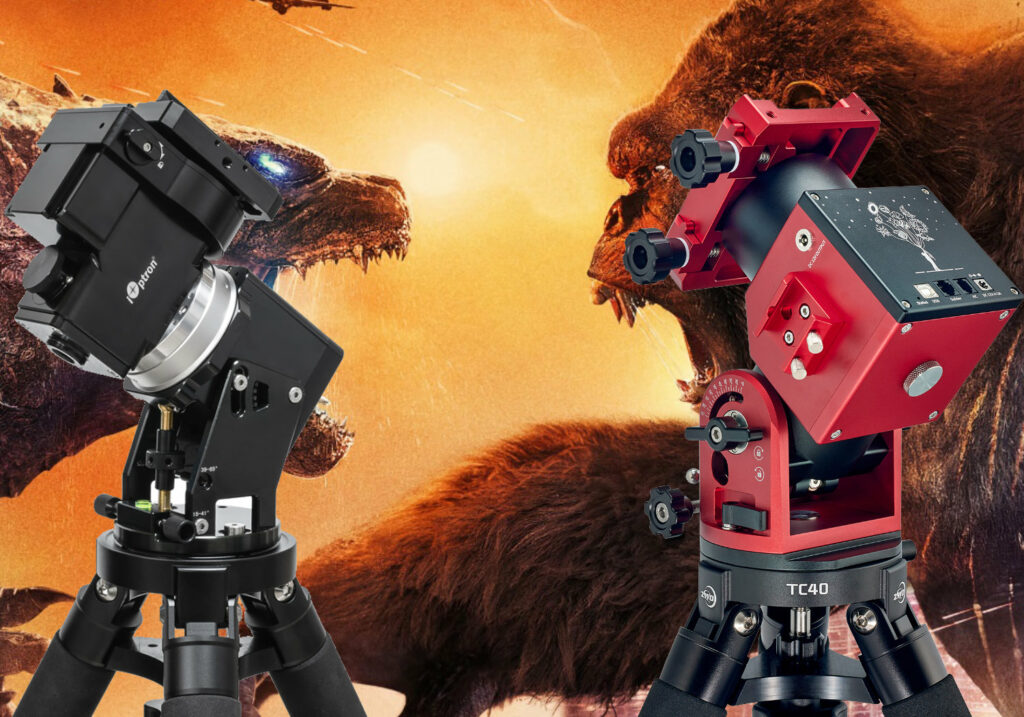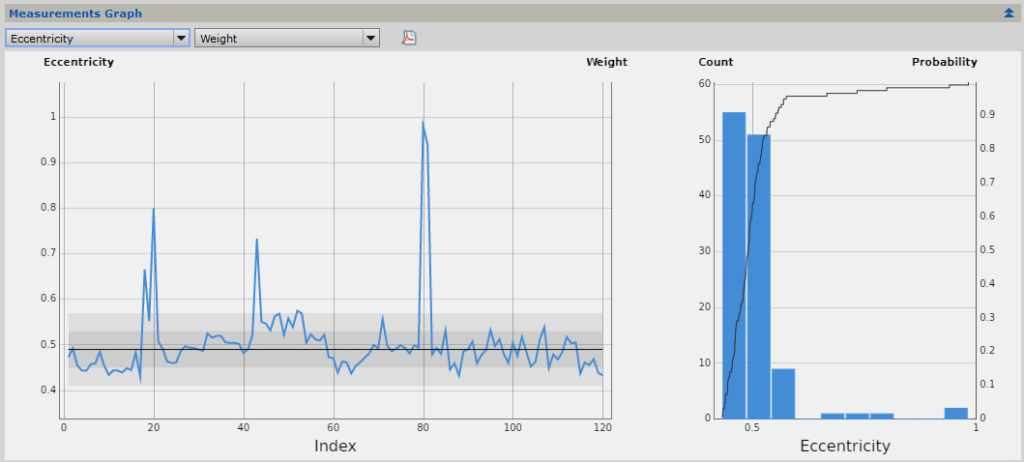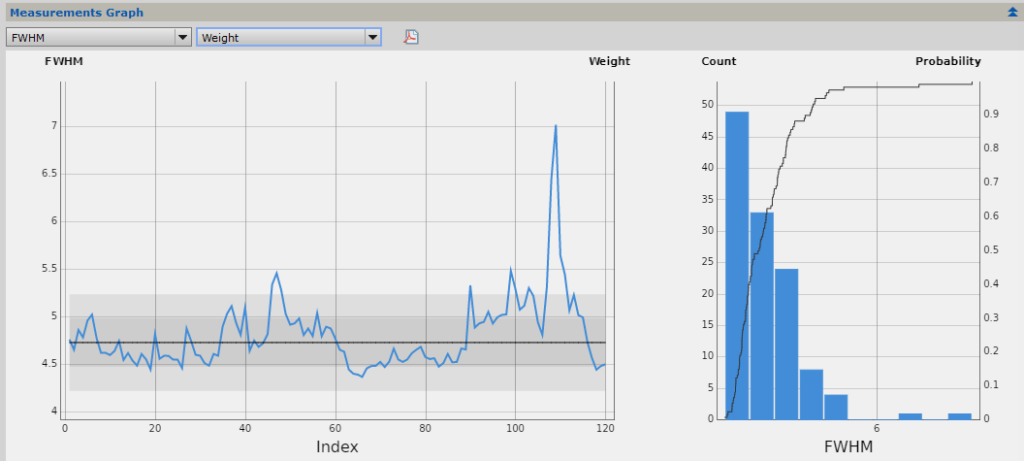
Preface
*All links in this article are direct links. I do not generate money from your clicks
For the reader of this article, I am not going to break down every single technical detail about these two mounts. Instead, it will include the following points.
- The switch to a strain wave mount
- Reasons why I didn’t choose the AM5
- Reasons why I chose the HEM27
- An unboxing video of the HEM27 with my Astrophotography Telescope equipment
- A head-to-head of data points of the iOptron HEM27 and ZWO AM5 using RedCats and ASI2600 cameras
- I final run with the HEM27 and a Celestron EdgeHD 8
The switch to the HEM27
Ok, it’s time to talk about losing weight, and I don’t mean exercise lol. I am talking about dropping weight with my Astro rig because there are new options in the telescope mount market these days using Stain wave gearing (also known as harmonic gearing) over traditional worm drive gears. These new mounts are tipping the scales in terms of being super light and packing a punch when driving heavier telescope gear. The big names in this new class of mounts as of the writing of this article are iOptron, Rainbow Astro, Sharpstar, and ZWO. I personally have been in the iOptron camp using the GEM28 since August 2021 and while almost not quite two years old I decided I wanted something lighter as I basically only capture photons of space under a dark sky and pack all my gear in my vehicle to get there.
Here is a weight comparison of the GEM28, the HEM27, and the AM5. The huge difference between the HEM27 and AM5 over the GEM28 is you don’t need a counterweight for the Right Accession axis as long as you’re not carrying more than 29.7 lbs of telescope gear on the HEM27 or 28 lbs on the AM5.
iOptron GEM28
Mount Head Weight: 10 lbs
DEC & RA: Uses Worm Gears
LightRoc Tripod 1.75: 15 lbs
Counter Weight: 10 lbs
Counter Weight Bar: 1 lb
Max Load Capacity: 28 lbs
Total Weight: 36 lbs **needs the counterweight and weight bar for balancing the mount properly
iOptron HEM27 w/ iPolar
Mount Head Weight: 8.15 lbs
RA: Uses Strainwave Gear
DEC: Uses Worm Gear
Carbon Fiber Tripod: 5 lbs
Counter Weight: 10 lbs
Counter Weight Bar: 1 lb
Load Capacity w/o Counterweight: 29.7
Load Capacity with Counterweight: 44 lbs
Total Weight: 13.15 lbs or 24.15 lbs with counterweight and bar
ZWO AM5
Mount Head Weight: 12 lbs
DEC & RA: Uses Strainwave Gears
Carbon Fiber Tripod: 5 lbs
Counter Weight: 10 lbs
Counter Weight Bar: 1 lb
Load Capacity w/o Counterweight: 28
Load Capacity with Counterweight: 44 lbs
Total Weight: 17 lbs or 28 lbs with counterweight and bar
So what did I gain by dropping all this weight? Well believe it or not quite a few things
- A mount that can handle up to 29.7 lbs of payload without a counterweight which is 1.7 lbs more payload than the GEM28 and if I use my old GEM28 counterweight and bar it can support up to 44 lbs of payload!
- Easier grab-and-go setup to travel to the GNTO as I have 22.85 lbs of less weight so it’s much easier to move around
- With the iOptron GEM28, I didn’t have a case, with the HEM27 it includes a case for the mount head for easy travel
- A well-positioned power port and USB port on the DEC head for easy installation of ASIAIR Pro/Plus/Mini and or Camera Cooler fan if you are a PC user
Why not the AM5?!?
So now that we got the weight out of the way which is the main reason to move to a strain wave mount you are probably wondering why in the world I didn’t go with the ZWO AM5, especially since I am a ZWO user and everyone and their mother is posting videos about how great this new mount from ZWO is. Well I can tell you right off the bat there are a few things that kept me from pulling the trigger with ZWO
Negatives
- This is the first mount that ZWO has released, while their products have been solid this is the first one to market
- I didn’t like the placement of the power out port, lots of reviewers have listed this as a concern about making sure your cables are well positioned on the mount so they don’t snag
- I don’t like the Nintendo Switch-type hand controller, I personally like to type in objects and hit go-to when using an eyepiece for observing
- The AM5 DEC does not have a brake so in the event of a power outage your telescope gear will swing and depending on where you’re telescope gear is pointed in the sky that could be an issue. iOptron has a brake on RA and a lock on DEC for the HEM mounts and brakes on both DEC and RA with all their HAE mounts.
- HEM27 uses a 480:1 reduction gear ratio, compared to the 300:1 of the AM5. A larger reduction gear has higher torque capability than a lower ratio. This means the HEM27 can handle more weight than the AM5, however, I am not one to push equipment past what it’s recommended by the manufacturer as I have seen way too many Home Improvement Episodes to mess with that.
- I don’t like the custom image on the AM5, while it doesn’t affect its quality it’s a silly design of a person holding ballons of galaxies and nebulas
Positives
- AM5 offers strain wave gears for both DEC and RA. The HEM27 only offers a strain wave gear for RA
- AM5 offers the ability to run the mount as an Equatorial and Azimuth mount. The HEM27 does not support this but the HAE mounts do
- AM5 offers a periodic error sheet for each mount they ship out. iOptron may add this in the future
Why the HEM27?
Now while the HEM27 is shortchanged on those three positives iOptron does sell the HAE Strain Wave Mounts which have the strain wave gear on both DEC and RA and they also support both Equatorial and Azimuth. The reason I went with the HEM over the HAE mounts was that the power out on the DEC head meets my needs more.
Other reasons why I stuck with iOptron
- iOptron’s first mount, Cube, selling in the USA under the iOptron brand in 2007. Prior to iOptron, GotoStar motorized mount control and telescope accessories were released as early as 1993. So they have been in the game as long as Wu-Tang so I can get behind that!
- iOptron has fantastic support and responds quickly, also they go over your PHD2 logs that you send them to verify potential issues with the mount or issues with your polar alignment. Their official business hours are 9:00 – 5:00 however email support does not restrict to business hours or holidays. They do recommend email as a reliable source of support.
- iOptrons design and engineering team are based in USA and China. Some models, especially high-end products are built in the USA while others are in China.
- iOptron support is based in the USA, providing service mainly in North America, as well as all over the world. They have dealers and distributors in Europe and other countries providing service locally. Customers can always choose to ship products to the USA for service as well.
- iPolar while not the only option for polar alignment does come built in and allows me to polar align if I am not using the ZWO ASIAIR.
Now with all that said if you look for my user name Joey Troy on Cloudy Nights you will see I have had issues with the GEM28 as I purchased one of the 2021 rushed-out-the-door mounts. iOptrons support has been super helpful sending me docs to make tweaks to the mount which resolved most of my issues. While it’s never been super perfect with RA RMS errors that didn’t stop me from still collecting some solid data however I have been losing 15-20% of my subs due to issues with RA guiding.

So with the continued issues of RA guiding iOptron Support recommend I send back the GEM28 head to repair it. Instead of the repair, I posed a question to see if it was possible to return the GEM28 head for credit and upgrade to the HEM27 if I was willing to do some YouTube reviews and a blog post. Normally iOptron does not offer any trade-in option like this however because I was offering the reviews they allowed it and also waived restocking fees for me. I still paid $1,584.60 out of pocket for the HEM27 and Carbon Fiber mount along with shipping fees for sending back the GEM28 head. So while not free I still feel it worked out for iOptron and me, especially since I still have the LightRoc Tripod, two 10lb counterweights, a counterweight bar, and a counterweight extension bar.
iOptron HEM27 Unboxing & Setup
Here is a walk-through of unboxing and setting up the mount and a little walk-through of my equipment and also the Azimuth Bolt install I missed.
iOptron HEM27 VS ZWO AM5
Preface
So before reading on I have a little info to share. Nico from NebulaPhotos did a triple head-to-head with the SkyWatcher EQ6-R Pro, the ZWO AM5, and iOptron HEM27 called HARMONIC DRIVE Mounts Showdown! If you watch the video the AM5 outperformed the HEM27. When I watched this video I was bugged by Nico as he normally does solid reviews. If anyone knows anything about astrophotography this type of head-to-head is not a true head-to-head as you are dealing with different atmospheric distortion throughout the night and seeing will be different higher to the zenith than lower to the horizon. Also, he imaged the same object all night long starting with the AM5 which was probably closer to the zenith with better seeing and guiding which means it’s very possible the HEM27 was lower to the horizon with poorer seeing and poorer guiding.
So to create a true proper head-to-head of the iOptron HEM27 vs ZWO AM5, my buddy Bob has agreed to assist me with an almost identical telescope equipment battle. I will also offer up all the logs from both devices including all the settings we used on both Astro Rigs. I have also taken the liberty of including the Davis Weather data and SQM readings from the GNTO during our session so you can have the full undisclosed, unbiased representation of both these quality mounts and the weather we had to deal with when imaging. It’s also important to mention that while the weather can have an effect on guiding so can the quality of the tripod, balancing of your equipment, and proper polar alignment.
The Astro Rigs
Joey’s Astro Rig


- Mount: iOptron HEM27
- Telescope: William Optics Redcat II
- Telescope Component: ProAstroGear Black-CAT Mount
- Controller: ZWO ASIAIR Plus v2.1-10.74
- Camera: ZWO ASI2600MM Pro
- Filter Wheel: ZWO EFW 8 x 1.25″ / 31mm
- Filers: Astronomik L-2 Luminance UV/IR Block 36 mm · Astronomik Deep-Sky Red 36 mm · Astronomik Deep-Sky Green 36 mm · Astronomik Deep-Sky Blue 36 mm
- Focuser: ZWO EAF v2
- Guiding: OAG-L + ASI290mm / Bin2 guide settings
- Battery: Jackery 500
Bob’s Astro Rig



- Mount: ZWO AM5
- Telescope: William Optics Redcat II
- Telescope Component: ProAstroGear Black-CAT Mount
- Controller: ZWO ASIAIR Plus v2.1-10.74
- Camera: ZWO ASI2600MC Pro
- Filter: Optolong L-Ultimate 2″
- Focuser: ZWO EAF v2
- Guiding: OAG-L + ASI290mm / Bin2 guide settings
- Battery: Jackery 290
- Telescope Driver: Lego Storm Strooper
ASIAIR Mount and Guide Calibration Settings
When we started both our Polar alignments were damn near perfect mine was 0.04 arc seconds and Bob’s was 0.03 arc settings.
To baseline both these mounts we dialed in our guide settings and then did a recalibration of the mounts once we polar aligned and slewed to our target. For both our mounts the ASIAIR Plus defaults to x 0.5 sidereal speed. For our Calibration Settings, we based them on Chen’s post on the ZWO forums. Here are our guide camera settings from astronomy tools. We are both binning 2×2 on our guide camera.

Joey’s Mount
Calibration Step: 1277 (4.79×2)/(15*0.5)
Max Dec: 2500 (recommend per PD2)
Max Ra: 2500 (recommend per PD2)
Bob’s Mount
Calibration Step: 1277 (4.79×2)/(15*0.5)
Max Dec: 2500 (recommend per PD2)
Max Ra: 2500 (recommend per PD2)
We also used calibrated Darks as well for both guide cameras which is a newer setting in the ZWO Software.
The Weather
Unlike Nico’s video, I wanted to share the true weather all night, along with SQM readings. Once we got everything calibrated for our mounts we kicked off our auto runs as well. While the evening started out amazing the seeing degraded through the night and was causing issues for both our mounts in terms of guiding.
Joey Started: 2023/04/15 9:34:45 PM / Ended 2023/04/16 02:19:47 AM
Bob Started: 2023/04/15 9:33:51 PM / Ended 2023/04/16 02:22:38 AM


The Guiding
Now for the section, everyone is waiting for. I have also attached the full logs for both our mounts so you can look at all the data for the whole image run. If you look at my logs my polar alignment was drifting much harder than Bob’s was and the guiding took a hit because of it. The numbers show Bob’s mount guided much better than mine. The only thing I can think of that affected my guiding was the tripod difference. Bob had multiple weights in his weight bag and also the Jackery 290 sitting in that weight bag. Sadly the iOptron does not offer a weight bag and something I may look into in the future. For averages, I only took the guidings that were 30 minutes or more I had 5 and Bob had 4.
Joey’s Average Guiding RMS: 1.02
Joey’s Average Polar Alignment Error: 8.72
Bob’s Average Guiding RMS: 0.69
Bob’s Average Polar Alignment Error: 1.47
Full PHD2 Logs – can be viewed in PHD2 Logviewer
The Image Pixels in PixInsight
Finally, Bob gave me all his images and allowed me to run calibrations on them in PixInsight. I kept all our images good bad or indifferent and ran them against Subframe Selector Tool
Joey’s Images 120 images @ 120s LRGB



Bob’s Images 120 images @ 120s OSC



An Almost Final Verdict – Celestron EdgeHD 8
So numbers don’t lie especially when you get to see them all. Based on everything I am seeing the ZWO AM5 performed much better than the iOptron HEM27 for guiding. The big reason for this was my setup and “cheap way” of balancing the RedCat. I fixed that by replacing the $14.00 counterweights I bought at Ace Hardware and purchased the William Optics Swan Dovetail Plate for Losmandy Style Saddle from Agena Astro https://agenaastro.com/william-optics-losmandy-style-type-d-dovetail-plate-red.html. Since doing that it’s amazing in terms of guiding and doesn’t have the slop balance issues like it used to with the other counterweights.
Now before I throw in the flag and call it a done battle I want to show you a very different setup with the iOptron HEM27, I offer up to you the following setup which was used 4/21/23-4/22/23 from its first light. I also have the Weather and SQM listed below.
Joey’s Galaxy Hunter

- Mount: iOptron HEM27
- Counter: iOptron Counterweight Bar & 10lbs Weight
- Telescope: Celestron EdgeHD 8 @ 2100MM Focal Length
- Controller: ZWO ASIAIR Plus v2.1-10.74
- Camera: ZWO ASI2600MM Pro
- Filter Wheel: ZWO EFW 8 x 1.25″ / 31mm
- Filers: Astronomik L-2 Luminance UV/IR Block 36 mm · Astronomik Deep-Sky Red 36 mm · Astronomik Deep-Sky Green 36 mm · Astronomik Deep-Sky Blue 36 mm
- Focuser: ZWO EAF v2
- Guiding: OAG-L + ASI174mm / Bin2 guide settings (should have done Bin1)
- Battery: Jackery 500
Now while the ZWO AM5 did outright beat me in the RedCat Battle log file we can see with these unedited logs using the EdgeHD 8 at full focal of 2100mm Focal Length guiding is pretty impressive and there is very little polar alignment error from one log to the next which means I must have forgotten to tighten something down when battling Bob. I did an average on any run over 27 minutes based on 6 runs in the EdheHD log.
EgdeHD 8
Joey’s Average Guiding RMS: 0.91
Joey’s Average Polar Alignment Error: 0.7
As you can see using the EdgeHD 8 was quite impressive compared to the RedCat with the counterweight.
RedCat 51
Joey’s Average Guiding RMS: 1.02
Joey’s Average Polar Alignment Error: 8.72
So regaurdless of all the numbers the only thing that matters is if you purchase an iOptron or a ZWO mount you will be doing just fine, just be careful of cable snags with your expensive gear.
And finally here are some combined data from both runs I realize this was one of my longer posts but I think it has some solid information and hope it was helpful for you to see. Till next time!
Markarian’s Chain data from Joey and Bob



